The February meeting started with the election of
officers. Congratulations to President
Maxine, VP Julie, Treasurer Jodi, and Secretary Carol. Members approved changing meeting start times
to 1PM; this change goes into effect with our March meeting.
It was obvious we didn’t meet in January—wow, what a lot of
show & tell! See separate post for
all the details.
Carol started us off on an exploration of yarn. If you go out onto the Internet in search of
information about fibers and yarns, you find yourself on a variety of websites
devoted to spinning, weaving and knitting—but no crochet. Why is that? It could be because crocheters are accustomed to
using thread, which is a fairly standardized commodity. However, if you look at this group’s show &
tell postings, you’ll see that our members do venture far beyond thread. It’s time we took a closer look at yarn. There’s ton on information available on
Wikipedia and other sites.
There are two characteristics of yarn to which we must pay
attention: fiber content and yarn
construction (number of ply and type of twist).
Every different type of fiber has its own set of qualities that separates
it from other types. Fibers from sheep
tend to have a memory: you can stretch
them, you can wash them, and they tend to “snap back.” Not so with all wool fibers, which can come
from goats, alpaca, and so on. Some wool
fibers are silkier than others, and some have more sheen. It pays to know the characters of many
different wool fibers so that when you see a particular breed of sheep or type
of animal noted on the yarn label, you’ll have an idea how those fibers will
behave.
You may have read somewhere that Z twist yarns are better
for crochet than S twist yarns. Finished
yarn is twisted to the left (counterclockwise) or to the right (clockwise). Yarn can be composed of a single ply (one
strand of twisted fibers) or multiple ply (several strands twisted together,
usually in pairs). The fatter the yarn,
the less twist it needs to hold together; the thinner the yarn, the more
twist. There is a lot more twist in
crochet thread than there is in a worsted weight singles.
The process a right-handed crocheter goes through to wrap
yarn around the hook for a triple crochet serves to put more twist into a Z
twist yarn and subtracts twist from an S twist yarn; the opposite is true for
left-handed crocheters. If you are a
devotee of the yarn reviews on Ravelry, you have probably noticed that some
knitters complain about singles yarn falling apart as they knit. This can be because they are right-handers
knitting continental style with an S twist singles; they use yarn in a similar
fashion to crocheters. If you have ever
worked on a knit or crochet project and had to stop and untwist a skein that
seems to have gotten tighter as you have progressed, this is because the act of
knitting or crocheting is adding twist to the yarn. It does not matter if you knit, crochet or
weave, any process of using yarn will either add to or subtract from the twist
the yarn had at manufacture.
If you want to make your yarn work to your benefit and not
your detriment, learn more about fiber and yarn construction. There is a wealth of information to be found
in sources devoted to spinning, knitting and weaving, and many yarn handling
tips specific to these disciplines. Be
sure to investigate wraps per inch, as yarns of the same weight can have very
different thicknesses. And when you make
a swatch, make sure you make it large enough and keep it on hand. Don’t “make gauge” before starting a project
and never consult that swatch again; rather, compare that swatch to your
crocheting as your project progresses.
Because there is much to learn about yarn and we ran out of
time at the February meeting, we will continue our exploration of yarn at the
March meeting.





















